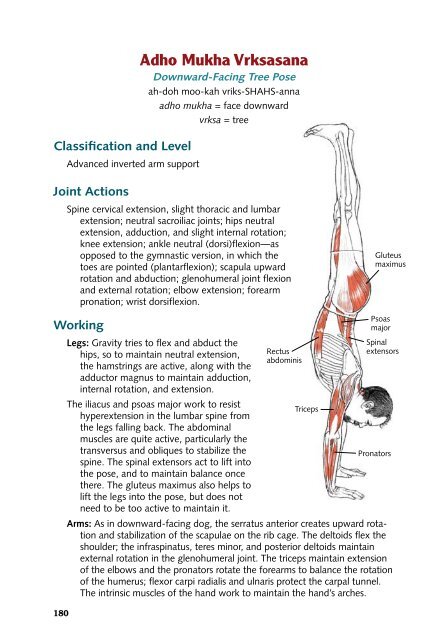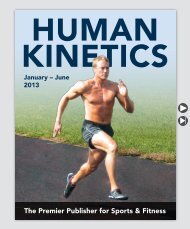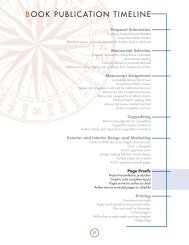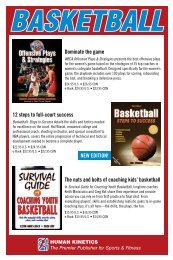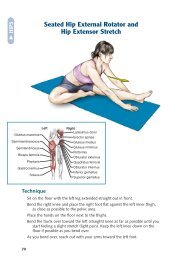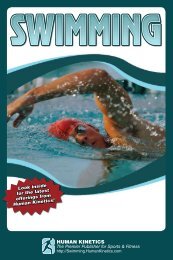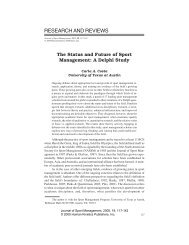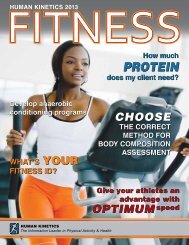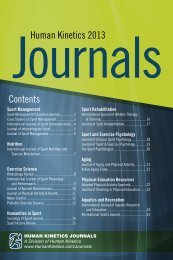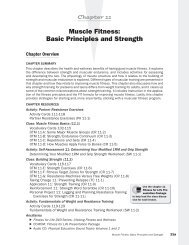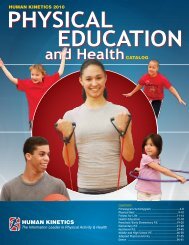Adho Mukha Vrksasana - Human Kinetics
Adho Mukha Vrksasana - Human Kinetics
Adho Mukha Vrksasana - Human Kinetics
Create successful ePaper yourself
Turn your PDF publications into a flip-book with our unique Google optimized e-Paper software.
Classification and Level<br />
Advanced inverted arm support<br />
<strong>Adho</strong> <strong>Mukha</strong> <strong>Vrksasana</strong><br />
Downward-Facing Tree Pose<br />
ah-doh moo-kah vriks-SHAHS-anna<br />
adho mukha = face downward<br />
vrksa = tree<br />
Joint Actions<br />
Spine cervical extension, slight thoracic and lumbar<br />
extension; neutral sacroiliac joints; hips neutral<br />
extension, adduction, and slight internal rotation;<br />
knee extension; ankle neutral (dorsi)flexion—as<br />
opposed to the gymnastic version, in which the<br />
toes are pointed (plantarflexion); scapula upward<br />
rotation and abduction; glenohumeral joint flexion<br />
and external rotation; elbow extension; forearm<br />
pronation; wrist dorsiflexion.<br />
Gluteus<br />
maximus<br />
Working<br />
180<br />
Legs: Gravity tries to flex and abduct the<br />
hips, so to maintain neutral extension,<br />
the hamstrings are active, along with the<br />
adductor magnus to maintain adduction,<br />
internal rotation, and extension.<br />
The iliacus and psoas major work to resist<br />
hyperextension in the lumbar spine from<br />
the legs falling back. The abdominal<br />
muscles are quite active, particularly the<br />
transversus and obliques to stabilize the<br />
spine. The spinal extensors act to lift into<br />
the pose, and to maintain balance once<br />
there. The gluteus maximus also helps to<br />
lift the legs into the pose, but does not<br />
need to be too active to maintain it.<br />
Rectus<br />
abdominis<br />
Triceps<br />
Psoas<br />
major<br />
Spinal<br />
extensors<br />
Pronators<br />
Arms: As in downward-facing dog, the serratus anterior creates upward rotation<br />
and stabilization of the scapulae on the rib cage. The deltoids flex the<br />
shoulder; the infraspinatus, teres minor, and posterior deltoids maintain<br />
external rotation in the glenohumeral joint. The triceps maintain extension<br />
of the elbows and the pronators rotate the forearms to balance the rotation<br />
of the humerus; flexor carpi radialis and ulnaris protect the carpal tunnel.<br />
The intrinsic muscles of the hand work to maintain the hand’s arches.
Latissimus dorsi<br />
Trapezius<br />
Deltoid<br />
Gluteus<br />
maximus<br />
Spinal<br />
extensors<br />
Triceps<br />
External obliques<br />
Flexor<br />
carpi<br />
radialis<br />
Obstacles and Notes<br />
If the latissimus dorsi are tight, the flexion and upward rotation of the arms can<br />
cause hyperextension in the lumbar spine.<br />
Hands and wrists alert: It’s very challenging to maintain the integrity of the<br />
hands with all the weight of the body balancing on them, but it’s essential in this<br />
pose, because collapsing into the wrist or heel of the hand is quite dangerous for<br />
the carpal tunnel and the nerves passing through it.<br />
Overuse of the gluteus maximus and latissimus dorsi can create more of a<br />
banana-shaped pose, which is admittedly easier for balance and may feel more<br />
stable for many people. Doing a handstand with a neutral spine is far more challenging<br />
and recruits more core muscular strength.<br />
For hypermobile students, it is especially important to find the strength of<br />
deep, intrinsic muscles, so that the pose doesn’t become rigid, but is both stable<br />
and fluid . . . available for breathing.<br />
Breathing<br />
Handstand is one of the most difficult poses in which to breathe effectively. The<br />
combined action of the core supporting muscles, working to minimize shape<br />
change in the spine, also minimizes the breath movements. Add to this the challenges<br />
of balancing, inversion, and strong upper-body action, and breathing is<br />
likely to be relegated to an afterthought at best.<br />
Many people instinctively hold their breath in handstand, partly out of fear,<br />
but also because of a need to stabilize the movements of the spine. Of course, to<br />
maintain this balance for more than a few seconds, the breath must be integrated<br />
into the pose—not necessarily as deep, full breaths, but as quick, efficient breaths<br />
that don’t disrupt the balancing or stabilizing actions of the core musculature.<br />
181


